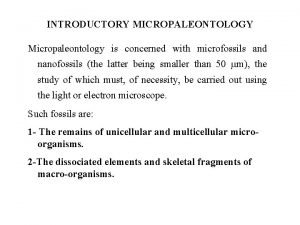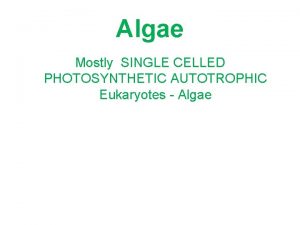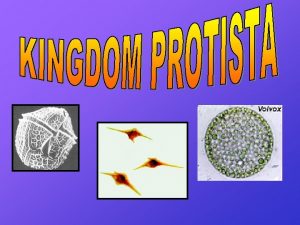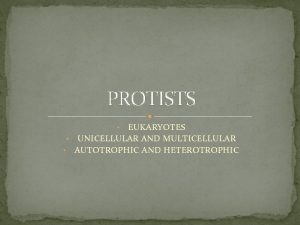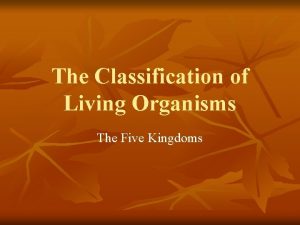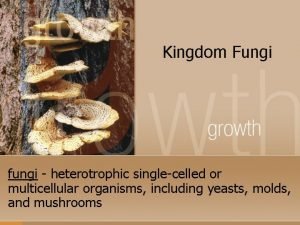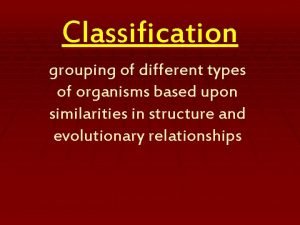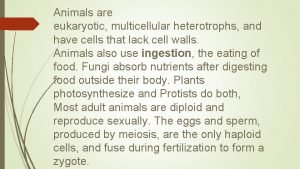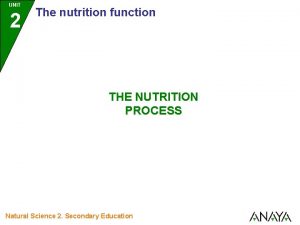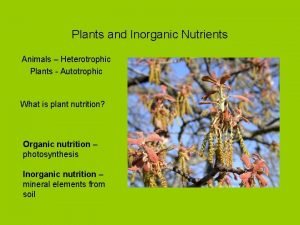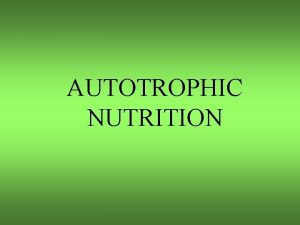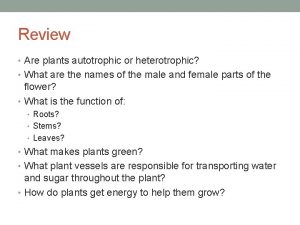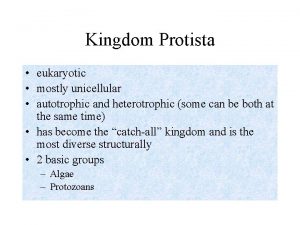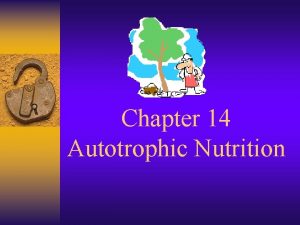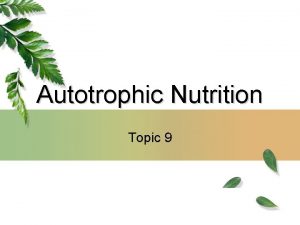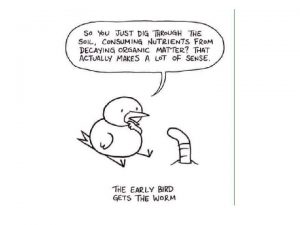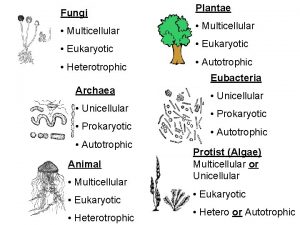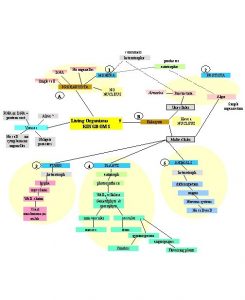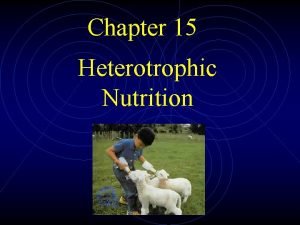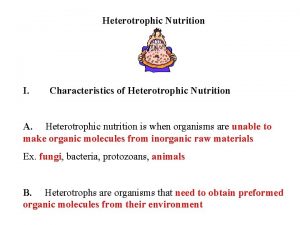Plants and Inorganic Nutrients Animals Heterotrophic Plants Autotrophic



















- Slides: 19

Plants and Inorganic Nutrients Animals – Heterotrophic Plants - Autotrophic What is plant nutrition? Organic nutrition – photosynthesis Inorganic nutrition – mineral elements from soil

How is mineral nutrition studied under controlled conditions? Ideal Concentration Of Elements For The Vegetative & Reproductive Stages Of Cucumber Plants do not need soil to grow if they are supplied with specific mineral nutrients Hoaglands Solution Note that the amounts required will be higher than found in most soils. Why? Elements Vegetable State Reproductive Stage N 251 ppm 225 ppm P 70 ppm 60 ppm K 220 ppm 280 ppm Ca 200 ppm 140 ppm Mg 60 ppm Fe 20 ppm Mn 2 ppm B 1 ppm Cu 0. 1 ppm Mo 0. 2 ppm Zn 1. 0 ppm

Hydroponics Nutrient film technique “aeroponics”

How is mineral nutrition studied in the field? Nutrient addition experiments at Rothhamstead Experimental Station Conclusions: Nutrient availability influences growth, species abundance, competition and soil microbial populations Park Grass Experiment started in 1856 (shown in 1941) Variables: p. H, P, K, Mg, Na, nitrate-N, ammonium-N and Silicon Fertilized plots have fewer species (2 -3) vs. unfertilized 50 -60)

What are the essential nutrients? Essential nutrients are needed for a plant to complete its life cycle and/or part of some essential plant part or molecule 17 nutrients: Macronutrients – H, C, O, N, K, Ca, Mg, P, S Micronutrients – Cl, b, Fe, Mn, Zn, Cu, Ni, Mo Nitrogen deficiency in corn

What are the roles of the essential nutrients? Nitrogen – 80% of atmosphere, but not in the form available to plants Pathway of absorption: NO 3 -(nitrate) NH 4+(ammonia) amino acids (proteins, nucleic acids, etc)

Phosphorous – often most limiting element in natural environment Why? 1. uptake from soil based on p. H: <6. 8 readily taken up; 6. 8 – 7. 2 less readily taken up; >7. 2 not available to plants 2. Organic phosphate must first be converted to an organic form by soil microbes before it can be taken up by the roots (some plants secrete phosphatase into soil) What are the roles of the essential nutrients?

Sodium – Desert plants (Atriplex vesicaria) involved with C 4 pathway Silicon – Taken up from soil 1 -2% of dry weight of corn ~16% dry weight of Equisetum arvense (Scouring Rush) involved with limiting fungal infections and preventing lodging Cobalt – legumes; required by symbiotic N 2 fixing bacteria Selenium – accumulates in arid soils of western US; toxic to most plants; accumulated by certain legumes (Astragalus example of a “Locoweed”) What are the beneficial nutrients?

Plant requirements for nutrients is defined in terms of critical concentration Critical concentration – supply of nutrient (measured in tissues) just below concentration that gives maximum growth

Plants exhibit either morphological or biochemical deficiency symptoms Nitrogen - mobile Mobile elements – symptoms first seen in older leaves Immobile elements symptoms first seen in younger leaves Manganese - immobile

Roots, soil and nutrient uptake Soil has two phases: Liquid phase – water or soil solution, gases, microorganisms Solid phase – mineral particles derived from rock, plus organic matter Soil solution is a very dilute (~1 m. M) solution of ions Roots take up nutrients from soil solution that are replenished by release from solid phase From: http: //www. laspilitas. com/advanced/pictures/roo ts. jpg

Soil as a nutrient reservoir Soil has both inorganic and organic colloids: Soil clay (<0. 002 mm particles), silt (0. 02 -0. 002), sand (0. 2 -0. 02) Clay forms a colloid (particles too small to settle out, too large to go into solution (Tyndall Effect) Colloidal humus-organic material that has been degraded to a colloidal dimension Nutrient contribution: colloidal humus > colloidal clay (in good soil)

How do soil colloids work? Effectiveness of colloids depend on: Surface area: more area, more nutrient ions can be held Surface charge: Clay – kaolinite (mostly negative charges from ionized aluminum and silica at edge of particle) Colloidal carbon – negative charges because of exposed carboxyl and hydroxyl groups

How do ions get from the soil into the plant?

Are all ions taken up by a plant equally? Accumulation ratio – Ci (conc. inside cell)/C 0 (conc. outside cell) Ion Co Ci Ci/Co K+ 0. 14 160 1142 Na+ 0. 51 0. 6 1. 18 NO 3 - 0. 13 38 292 SO 4 - 0. 61 14 23

How do ions get across root cell membranes? Carriers – selectivity with low transport rates Ion channels – high transport rates (ex. K+ rates into guard cells)

Root – Microbe Interactions Root –bacteria interactions Root cap mucilage www. ffp. csiro. au/research/ mycorrhiza/root. html Cluster or proteoid roots http: //www. tau. ac. il/~ecology/virtau/3 philip_nemoy/image 006. jpg

Root – Microbe Interactions Ectomycorrhizae on pine roots http: //www. forestpests. org/nur sery/images/fnp 0 -7. jpg Endomycorrhizae http: //www. mun. ca/biology/singleton/T opic%2012/37 -14 -Mycorrhizae. jpg

Benefit of mycorrhizae
 Protist characteristics
Protist characteristics Basidiomycetes heterotrophic or autotrophic
Basidiomycetes heterotrophic or autotrophic Micropaleontology lecture notes
Micropaleontology lecture notes Is fucus autotrophic or heterotrophic
Is fucus autotrophic or heterotrophic Are rotifers autotrophic or heterotrophic
Are rotifers autotrophic or heterotrophic Is a paramecium autotrophic or heterotrophic
Is a paramecium autotrophic or heterotrophic Multicellular heterotrophic
Multicellular heterotrophic Is protoctista autotrophic or heterotrophic
Is protoctista autotrophic or heterotrophic Are fungi all multicellular
Are fungi all multicellular Is euglena autotrophic or heterotrophic
Is euglena autotrophic or heterotrophic Organic and inorganic nutrients
Organic and inorganic nutrients Is a horse a producer consumer or decomposer
Is a horse a producer consumer or decomposer G h patel college of engineering and technology
G h patel college of engineering and technology Animals that eat both plants and animals
Animals that eat both plants and animals All animals are multicellular heterotrophs
All animals are multicellular heterotrophs Autotrophic plants examples with names
Autotrophic plants examples with names Autotrophic plants examples
Autotrophic plants examples Binomial nomenclature examples
Binomial nomenclature examples Inorganic plants
Inorganic plants Heterotrophic plants
Heterotrophic plants


